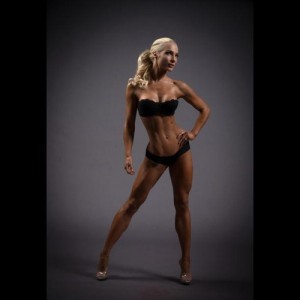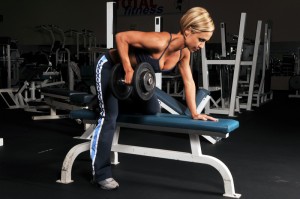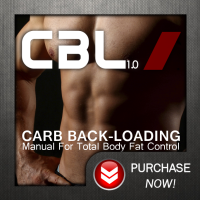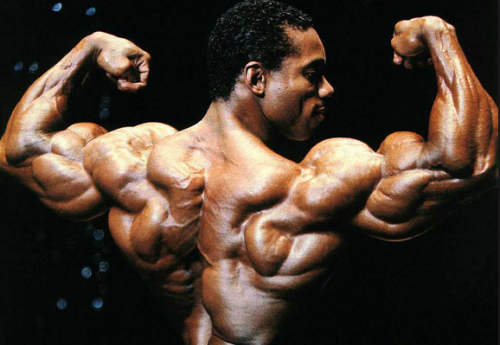If you want to get stronger, you have to get bigger, right? That’s what most people believe, and it’s essentially become a set-in-stone concession among all athletes, male and female, that in order to add significant amounts of strength, we also have to pack on significant amounts of bulk and fat. Look at any powerlifter or off-season bodybuilder and you’ll see exactly what I mean—that’s not what you want, if you want to be the ideal sexy, strong woman.
Conversely, it’s also assumed that getting lean is synonymous with getting weaker. This is derived from the first premise. When size disappears, so does strength. It doesn’t have to be that way, though. After decades of training, what I’ve learned is that with careful training considerations and an optimal diet, women can be strong and lean without getting fat, bulky, or weak.
Lean Strength
My athletic background is primarily in track and field, and I was a collegiate track athlete. My training back then consisted of high-volume leg exercises, along with a ton of sprints. The result? Big, voluptuous quads. For bodybuilding, this may be exactly what you’re looking for. For the majority of women I’ve worked with, however, what’s most important is getting strong and lean without all that added “bulk.” 
What, then, is the best way to do this?
For well over a decade, I’ve been a major advocate of powerlifting-style training. Most times, powerlifting training consists of heavy weights done for lower reps. This results in a far lower overall training volume. And because your actual volume is relatively low, you won’t experience as much muscular growth as you would from higher volume programming.
At this point, you have to make a choice. Which exercises should you do powerlifting-style in order to get stronger without adding mass, and which should you add to your programming in higher volumes? Well, the programming work here has already been done for you. By utilizing a style of training known as the Conjugate Method, it’s possible to achieve great gains in strength without adding massive amounts of bulk.
Conjugate Training
The first exercise you’ll perform is called your max effort (ME) movement. ME training forces you to strain yourself under heavy loads, which will improve the efficiency of your central nervous system (CNS). Training your CNS to become more efficient is what will allow you to get stronger. There are three main characteristics to ME training:
1. You’ll be lifting near-maximal weights, so your intensity (the percentage of your one-rep max) will be high (90-100+ percent).
2. Since you’ll be lifting at such a high percentage of your one-rep max, you’ll be using very low reps (1-3, in most cases).
3. Because your overall volume will be so much lower, and your focus is on improving the efficiency of your CNS, your gains in muscle mass will be minimal.
Your next exercise will be a supplemental movement, or builder—so-called because it’s designed to “build” your main movement. For example, if your main movement is a sumo deadlift, your builder exercise might be something like arched-back good mornings, which will help strengthen the arch you’ll need to deadlift properly. Here are the key considerations for your builder exercise:
1. You’ll be using sub-maximal weights (60-85 percent of your one-rep max) for each exercise.
2. Use higher reps than you would for your main ME movement (in the 5-10 rep range).
3. The idea here is to improve the weakest point in your ME movement. You may have to play around with this a little, but if you improve this weak point, your main exercise will get much stronger.
The final 3-5 exercises of your program are called your assistance work. These are done for higher volume, and in most cases, they’ll be closer to bodybuilding movements than anything else. Regardless, the main idea is to choose these exercises based on where you’re weak or need more muscle. For the majority of women I work with, there are three main muscle groups that need to be “brought up” in terms of strength and mass: the hamstrings, lower back, and glutes (particularly the gluteus medius and the abductors).
Your volumes here will fall into the 10-20 rep range, and your intensity should still be fairly difficult—meaning your final few repetitions of each set will be difficult to perform.
Training low volume/heavy intensity with your main exercises and high volume/moderate intensity with your assistance exercises will allow you to get stronger and leaner without packing on the pounds, especially when done in conjunction with an optimal nutrition protocol like Carb Back-Loading. In fact, it’s a necessity to put the two—training and nutrition—together. Diet is just as much of a factor in strength gains as it is for getting lean, and that’s why I’ve been using Carb Back-Loading (with great success) for nearly two years.
With the Conjugate Method, I train four days per week. Two of these days are max effort sessions, and the other two are dynamic effort (DE) workouts, which I’ll cover in Part II of this article.
Right now, I’m a competitive powerlifter, and I need to stay in a weight class range for my competitions. This type of programming has been perfect for me, and I’ve been able to build a body that’s strong and lean. When I want to put on lean mass without adding pounds, I can tweak my diet and training and get the job done. For women who want to be physically strong and aesthetically lean—the sexy, strong woman—this style of training and diet is the way to go.









Recent Comments